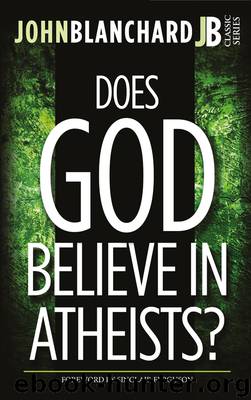Does God Believe in Atheists? by John Blanchard

Author:John Blanchard [Blanchard, John]
Language: eng
Format: epub, mobi
Tags: Christian Books & Bibles, Ministry & Evangelism, Evangelism, Theology, Apologetics, Politics & Social Sciences, Philosophy, Religious, Religion & Spirituality, Religious Studies, Religious Studies & Reference
ISBN: 0852347502
Amazon: B00LKJ5LTU
Barnesnoble: B00LKJ5LTU
Publisher: EP BOOKS
Published: 2014-07-01T22:00:00+00:00
18
The book that speaks for itself
Among the ancient artefacts carefully preserved in Magdalen College, Oxford, are three tiny papyrus fragments, the largest of which is no bigger than a postage stamp. Papyrus was once a cheap form of writing material made from the inner bark of a plant which grew along the banks of the Nile. Bequeathed to the college in 1901, these particular fragments were believed to date from the second century, but in 1994 the German papyrologist Carsten Thiede, one of the world’s leading experts in his field, redated them to the third quarter of the first century. All very fascinating—but why should this be of the slightest interest to the atheist or agnostic or, for that matter, to the theist? The reason is that the writing on those tiny scraps of parchment is from the Bible.
For many people today, the idea that the Bible has any bearing on our subject, let alone that it constitutes a problem for the atheist or agnostic, seems ludicrous. After all, the Bible is a higgledy-piggledy assortment of fantasy and folklore, long ago discredited by science, virtually irrelevant in today’s educated, sophisticated, post-modern world, and hardly worth the papyrus on which it was written—or is it?
In his Introduction to Research in English Literary History, military historian C. Sanders lays down three tests for assessing the reliability of ancient documents.1 The first is the bibliographical test, which asks such questions as these: How many manuscripts (handwritten copies) do we have? How good are they? How close are they to the original? The second is the external evidence test, which asks whether there is other contemporary evidence to confirm the statements of the document in question. The third is the internal evidence test, which asks whether the author concerned was writing truth or error, fact or fiction. How does the Bible measure up when subjected to these tests?
The message of the manuscripts
To begin with the first question in the bibliographical test, how many copies of biblical material do we have?
Since the discovery of the Dead Sea Scrolls in 1947 (more about this later), we have had well over 100 scrolls of Old Testament material to add to nearly 25,000 copies of all or part of the New Testament. The significance of these figures can be seen when we contrast them with some examples of those relating to other ancient documents. We have no more than ten copies of Caesar’s Gallic War (58–50 B.C.) and just twenty copies of Livy’s Roman History (59 B.C.–A.D. 17). For our knowledge of the Roman emperors from Augustus to Nero we have to lean heavily on ten copies of works by the Roman historian Cornelius Tacitus (born c. A.D. 52). We have only seven copies of the letters of the Roman author Pliny the Younger (c. A.D. 61–113), eight copies of the works of the Roman historian Suetonius (c. A.D. 69–140) and nothing we can completely trust about the King of Macedonia, Alexander the Great (356–323 B.C.), even though many later books have been written about him.
Download
Does God Believe in Atheists? by John Blanchard.mobi
This site does not store any files on its server. We only index and link to content provided by other sites. Please contact the content providers to delete copyright contents if any and email us, we'll remove relevant links or contents immediately.
Signature in the Cell: DNA and the Evidence for Intelligent Design by Stephen C. Meyer(2879)
Real Sex by Lauren F. Winner(2869)
The Holy Spirit by Billy Graham(2778)
The Secret Power of Speaking God's Word by Joyce Meyer(2755)
The Gnostic Gospels by Pagels Elaine(2400)
Jesus by Paul Johnson(2230)
Devil, The by Almond Philip C(2206)
23:27 by H. L. Roberts(2144)
The Nativity by Geza Vermes(2116)
Chosen by God by R. C. Sproul(2056)
All Things New by John Eldredge(2052)
Angels of God: The Bible, the Church and the Heavenly Hosts by Mike Aquilina(1870)
Angels by Billy Graham(1844)
The Return of the Gods by Erich von Daniken(1841)
Knowing God by J.I. Packer(1724)
Jesus of Nazareth by Joseph Ratzinger(1709)
Evidence of the Afterlife by Jeffrey Long(1705)
The Gnostic Gospel of St. Thomas by Tau Malachi(1680)
How To Be Born Again by Billy Graham(1670)
